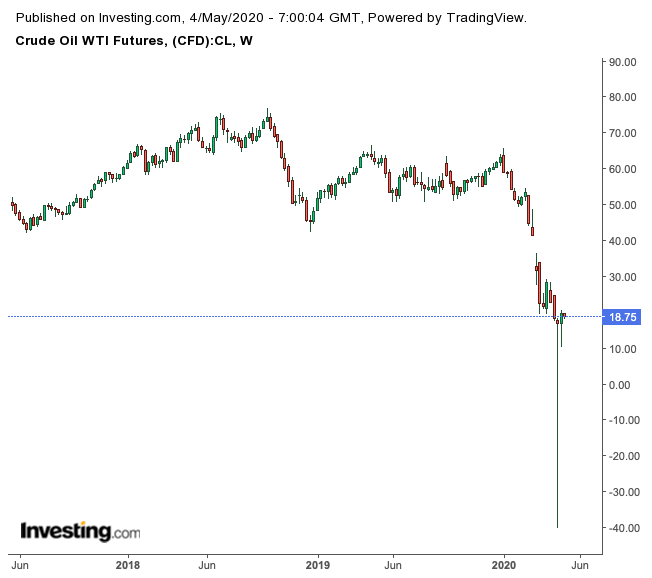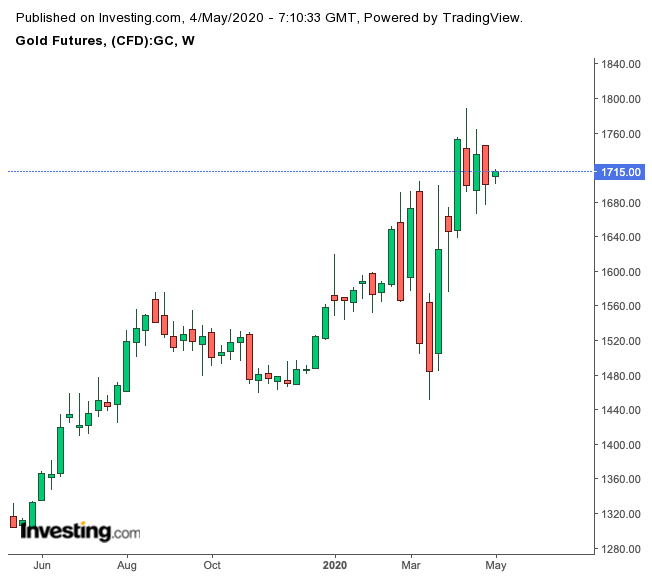Enough of the bull, say oil bears: it’s time to come clean on the cuts.
With OPEC’s promised production curtailments having kicked in from Friday, the market will be seeking hard proof beginning this week that barrels are coming off the market. Premature as that may be, short sellers sat on their hands over the past three sessions as U.S. crude gained 60% from the lows of last week and Brent climbed 32% in the same period. Hereon, the bears will be seeking evidence that at least some pressure is coming off the global storage system.
If that isn’t enough, President Donald Trump’s renewed trade war with China is already driving Wall Street’s Dow futures lower and the dollar higher—a lethal combination for oil.

Trump’s Election Strategy And China: “Last Thing Oil Needs”
“President Trump's election strategy in November seems clear already, and it is already weighing on markets globally,” said Jeffrey Halley, analyst at New York-based OANDA.
“The U.S. President, and his coterie of officials, appear intent on deflecting any blame for their allegedly inadequate response to the COVID-19 pandemic domestically, (and) instead, heaping the blame on China for everything.”
“A potential renewal of trade war hostilities is the last thing oil markets need right now,” Halley added.
Specifically on oil cuts, Moscow’s former energy minister Vladimir Milov said on Friday there were "too many technical challenges” for Russia to achieve its 2.5 million bpd quota for cuts. “Production cuts of such magnitude have never been done in Russia so we are venturing into the unknown,” Milov, now an opposition politician, told the Wall Street Journal.
Russia is key to the so-called GLOPEC production pact between global producers, including the United States, and the OPEC cartel led by Saudi Arabia that aims to reduce at least 9.7 million barrels per day from world supply to partially offset 20 million to 30 million of demand lost to the coronavirus pandemic. Without Moscow’s earnest participation, global oil inventories may not fall quickly enough for the market’s liking.
Russia Not Geared For Quick And Deep Cuts
According to those in the know, Russia’s oil infrastructure isn’t geared for quick and deep production cuts as the frigid Siberian climate can cause pipelines to burst without oil in them. Low-yielding Soviet-era fields are also expensive to maintain and restart, thus major Russian oil companies are lobbying the energy ministry for exemptions from the cuts, the Journal quoted industry analysts in Moscow as saying.
Mikhail Krutikhin, a partner at the independent RusEnergy consulting agency that advised Russian oil companies in recent weeks on the cuts, concurs with Milov. “They just don’t know how to do it,” he said of the companies that are supposed to be contributing to the cuts. “It’s a completely new paradigm.”
A Bloomberg survey on Friday showed that OPEC’s most powerful member, Saudi Arabia, pumped a record of more than 11 million barrels a day as it waged a price war against its former ally Russia. Though they reached a truce by mid-April, striking a deal to cut vast amounts of supply, the Saudis continued to keep production high for much of the month—even with demand suffering an unprecedented free-fall, Bloomberg reported.
As of two weeks ago, at least 160 million barrels were now stored at sea, outside global shipping ports from Singapore to Suffolk and along the U.S. Gulf Coast of Mexico. Forecasts suggest that the world’s conventional oil storage—which can hold about 3.4 billion barrels—will be filled to its limits by the end of May.
But That’s Not The Whole Story, Say Oil Bulls
Those who have a positive view on oil argue that the bears’ rhetoric does not account for output cuts by oil majors that aren’t part of the GLOPEC deal. Quotas were only handed out to national oil companies under the global production pact, or firms the governments could direct—like in Russia.
While that left the world’s oil majors to their own devices, Big Oil has been cooperating somewhat with GLOPEC too.
ConocoPhillips (NYSE:COP), for instance, says it will cut 420,000 bpd in June. Chevron (NYSE:CVX) says it will shut down 400,000 bpd and scrap 60 percent of its drilling rigs. In the Permian shale oil basin, Chevron has already cut rigs from 17 to 5. Oasis Petroleum (NASDAQ:OAS), meanwhile, is in the process of winding down all Bakken drilling, according to Reuters. The same news outlet reported on Thursday that Chesapeake Energy (NYSE:CHK), another shale pioneer, was in the process of filing for bankruptcy, making it potentially the second U.S. driller to go under since Whiting Petroleum (NYSE:WLL) in early April.
“Early reports suggest that compliance to cuts will be high,” said Phil Flynn, an analyst at the Price Futures Group in Chicago, who’s typically bullish on oil.
Also, this Tuesday, the Railroad Commission of Texas, responsible for regulating the largest U.S. oil producing state, will vote whether to approve a 20% output cut that will roughly take away about 1 million bpd.
Meanwhile, at least 30 of the 50 U.S. states have already reopened for business in one way or another from the lockdown measures forced by the COVID-19. That could bump up gasoline and diesel consumption, in what would be a nascent recovery.
But Cuts Are Trickling, Not Gushing, In
Notwithstanding these and other production shut-ins, the slump in oil rigs and cuts in capital expenditure announced by various oil drillers, the Energy Information Administration says U.S. crude production only fell by 1 million bpd by May 25, from a record high of 13.1-million-bpd in mid-March.
And while refineries may have started experiencing some demand for fuels, evidence of this is likely to trickle—rather than gush—in. Gasoline stockpiles fell by 3.7 million barrels during the week ended May 25, but crude stockpiles still rose by 9 million barrels, the EIA said.
Moreover, the Federal Reserve’s revision last week of its Main Street Lending Program—which allows larger and more indebted companies to qualify for lending—could be a double-edged sword for oil. While the Fed’s program helps shale drillers avoid bankruptcy, oil bears see that lifeline as meaning more production stays on the line.
In conclusion, Goldman Sachs says oil bulls need “time” and “patience” to ride out the storm.
“Oil remains a physical asset and will therefore need to first price to clear the substantial inventory overhang through 2H20, leaving the commodity to lag the rally in related anticipatory financial assets like equities,” Wall Street’s leading voice on energy said.
Gold Hinges On Jobs, China Blame-Game

In the case of gold, volatility and an equally strong dollar could keep the yellow metal in a range under $1,720 till midweek, though the dynamic could change if Trump goes ballistic with his China blame-game.
“Some sort of fears are there that the trade war might be ignited and such events are good for gold,” Avtar Sandu, senior commodities manager at Phillip Futures, told Reuters.
Gold’s final outcome for the week will depend on Friday’s April nonfarm payrolls report. The market is expecting a loss of 21,000K jobs for last month. If the decline overshoots, expect gold to reach above $1,730 or higher.
